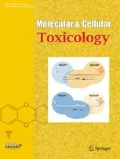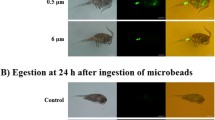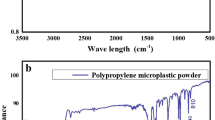Abstract
Backgrounds
The environmental impacts of microplastics (MPs) are increasingly of concern, particularly for their sources, global distribution, and persistency in aquatic ecosystems. Although the ubiquitous and persistent nature of MPs in waterbodies is evident, their effects and health implications for aquatic animals are still open to debate.
Objective
The brine shrimp, Artemia franciscana was exposed to different concentrations (1–1000 particles mL−1) of four sizes (1, 3, 6, and 10 μm) of non-functionalized polystyrene microbeads. To measure MPs effects, several physiological and biochemical parameters such as ingestion and egestion, stress biomarkers [e.g., heat shock protein 70 (hsp70) family, enzymatic activities of catalase (CAT) and superoxide dismutase (SOD)], acetylcholinesterase (AChE) activity, and survival rate for 30 days were analyzed.
Results
Exposure to waterborne MPs showed clear ingestion and egestion in A. franciscana. Exposure to relatively larger sizes of 1000 particles mL−1 MPs dose–dependently increased mRNA expression of hsp70 families and enzymatic activities of CAT and SOD within 96 h. Significant inhibitory effects on AChE activity were observed in response to 1000 particles mL−1 with increases in mortality for 30 days. Thirty-day survival of juveniles was dose-dependently affected, with greater effects seen at 1000 particles mL−1 of MPs.
Conclusion
Our results suggest that MPs exposure to the early stages of brine shrimp could be detrimental for population maintenance through inhibition of cholinergic system and the induction of acute cell stress, including oxidative stress.





Similar content being viewed by others
References
Andrady AL (2011) Microplastics in the marine environment. Mar Pollut Bull 62:1596–1605
Avio CG et al (2015) Pollutants bioavailability and toxicological risk from microplastics to marine mussels. Environ Pollut 198:211–222
Baek I, Choi HJ, Rhee JS (2015) Inhibitory effects of biocides on hatching and acetylcholinesterase activity in the brine shrimp Artemia salina. Toxicol Environ Health Sci 7:303–308
Batel A, Linti F, Scherer M, Erdinger L, Braunbeck T (2016) Transfer of benzo[a]pyrene from microplastics to Artemia nauplii and further to zebrafish via a trophic food web experiment: CYP1A induction and visual tracking of persistent organic pollutants. Environ Toxicol Chem 35:1656–1666
Bergami E et al (2016) Nano-sized polystyrene affects feeding, behavior and physiology of brine shrimp Artemia franciscana larvae. Ecotoxicol Environ Saf 123:18–25
Blarer P, Burkhardt-Holm P (2016) Microplastics affect assimilation efficiency in the freshwater amphipod Gammarus fossarum. Environ Sci Pollut Res Int 23:23522–23532
Bradford MM (1976) A rapid and sensitive method for the quantitation of microgram quantities of protein utilizing the principle of protein-dye binding. Anal Biochem 72:248–254
Browne MA et al (2011) Accumulation of microplastic on shorelines woldwide: sources and sinks. Environ Sci Technol 45:9175–9179
Cole M (2016) A novel method for preparing microplastic fibers. Sci Rep 6:34519
Cole M, Lindeque P, Halsband C, Galloway TS (2011) Microplastics as contaminants in the marine environment: a review. Mar Pollut Bull 62:2588–2597
Della Torre C et al (2014) Accumulation and embryotoxicity of polystyrene nanoparticles at early stage of development of sea urchin embryos Paracentrotus lividus. Environ Sci Technol 48:12302–12311
Duis K, Coors A (2016) Microplastics in the aquatic and terrestrial environment: sources (with a specific focus on personal care products), fate and effects. Environ Sci Eur 28:2
Ellman GL, Courtney KD, Andres V Jr, Feather-stone RM (1961) A new and rapid colorimetric determination of acetylcholinesterase activity. Biochem Pharmacol 7:88–95
Eriksen M et al (2014) Plastic pollution in the world’s oceans: more than 5 trillion plastic pieces weighing over 250,000 tons afloat at sea. PLoS ONE 9:e111913
Farrell P, Nelson K (2013) Trophic level transfer of microplastic: Mytilus edulis (L.) to Carcinus maenas (L.). Environ Pollut 177:1–3
Gambardella C et al (2017) Effects of polystyrene microbeads in marine planktonic crustaceans. Ecotoxicol Environ Saf 145:250–257
Geyer R, Jambeck JR, Law KL (2017) Production, use, and fate of all plastics ever made. Sci Adv 3:25–29
Jambeck JR et al (2015) Plastic waste inputs from land into the ocean. Science 347:768–771
Jamieson AJ et al (2019) Microplastics and synthetic particles ingested by deep-sea amphipods in six of the deepest marine ecosystems on Earth. R Soc open sci 6:180667
Junprung W (2019) Sequence and expression analysis of HSP70 family genes in Artemia franciscana. Sci Rep 9:8391
Kach DJ, Ward JE (2008) The role of marine aggregates in the ingestion of picoplankton-size particles by suspension-feeding molluscs. Mar Biol 153:797–805
Kim BM, Kim K, Choi IY, Rhee JS (2017) Transcriptome response of the Pacific oyster, Crassostrea gigas susceptible to thermal stress: a comparison with the response of tolerant oyster. Mol Cell Toxicol 13:105–113
Lee KW, Shim WJ, Kwon OY, Kang JH (2013) Size-dependent effects of micro polystyrene particles in the marine copepod Tigriopus japonicus. Environ Sci Technol 47:11278–11283
Lee DH, Eom HJ, Kim M, Jung JH, Rhee JS (2017) Non-target effects of antifouling agents on mortality, hatching success, and acetylcholinesterase activity in the brine shrimp Artemia salina. Toxicol Environ Health Sci 9:237–243
Lesser MP (2006) Oxidative stress in marine environments: biochemistry and physiological ecology. Annu Rev Physiol 68:253–278
Nunes BS, Carvalho FD, Guilhermino LM, Van Stappen G (2006) Use of the genus Artemia in ecotoxicity testing. Environ Pollut 144:453–462
Peixoto D et al (2019) Uptake and effects of different concentrations of spherical polymer microparticles on Artemia franciscana. Ecotoxicol Environ Saf 176:211–218
Pitt JA et al (2018) Uptake, tissue distribution, and toxicity of polystyrene nanoparticles in developing zebrafish (Danio rerio). Aquat Toxicol 194:185–194
Rech S et al (2014) Rivers as a source of marine litter - a study from the SE Pacific. Mar Pollut Bull 82:66–75
Rehse S, Kloas W, Zarfl C (2016) Short-term exposure with high concentrations of pristine microplastic particles leads to immobilisation of Daphnia magna. Chemosphere 153:91–99
Rhee JS et al (2009) Heat shock protein (Hsp) gene responses of the intertidal copepod Tigriopus japonicus to environmental toxicants. Comp Biochem Physiol C 149:104–112
Setälä O, Fleming-Lehtinen V, Lehtiniemi M (2014) Ingestion and transfer of microplastics in the planktonic food web. Environ Pollut 185:77–83
Thompson RC (2015) Microplastics in the marine environment: sources, consequences and solutions. In: Bergmann M, Gutow L, Klages M (eds) Marine anthropogenic llitter, Springer, Berlin, pp. 185–200
Varó I, Navarro JC, Amat F, Guilhermino L (2002) Characterisation of cholinesterases and evaluation of the inhibitory potential of chlorpyrifos and dichlorvos to Artemia salina and Artemia parthenogenetica. Chemosphere 48:563–569
Varó I et al (2019) Time-dependent effects of polystyrene nanoparticles in brine shrimp Artemia franciscana at physiological, biochemical and molecular levels. Sci Total Environ 675:570–580
Wang Y et al (2019) The uptake and elimination of polystyrene microplastics by the brine shrimp, Artemia parthenogenetica, and its impact on its feeding behavior and intestinal histology. Chemosphere 234:123–131
Welch WJ (1993) How cells respond to stress. Sci Am 269:56–64
Wright SL, Rowe D, Thompson RC, Galloway TS (2013) Microplastic ingestion decreases energy reserves in marine worms. Curr Biol 23:1031–1033
Acknowledgements
The work was supported by the Basic Science Research Program of the National Research Foundation of Korea (NRF) funded by the Ministry of Education (Grant no. NRF-2017R1A6A1A06015181).
Author information
Authors and Affiliations
Contributions
HJE and SEN contributed equally to this work; HJE and SEN performed most of the experiments, analyzed the results, interpreted the data, and wrote manuscript; JSR conceived, supervised and supported the whole study, and wrote manuscript.
Corresponding author
Ethics declarations
Conflict of interest
Hye-Jin Eom, Sang-Eun Nam, and Jae-Sung Rhee declare that they have no conflict of interest.
Ethical approval
The article does not contain any studies with human and animal that needed experimental permission, and this study was performed institutional and national guidelines.
Additional information
Publisher's Note
Springer Nature remains neutral with regard to jurisdictional claims in published maps and institutional affiliations.
Rights and permissions
About this article
Cite this article
Eom, HJ., Nam, SE. & Rhee, JS. Polystyrene microplastics induce mortality through acute cell stress and inhibition of cholinergic activity in a brine shrimp. Mol. Cell. Toxicol. 16, 233–243 (2020). https://doi.org/10.1007/s13273-020-00088-4
Accepted:
Published:
Issue Date:
DOI: https://doi.org/10.1007/s13273-020-00088-4




